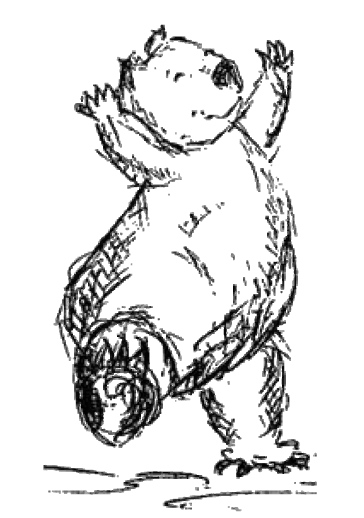“Mum, why can’t I go to Guides any more?”
Every time my daughter asks this, it cuts me to the core. Starting off in Junior Guides, she was involved for around eight wonderful years. At the age when girls usually progress to Ranger Guides, her unit happily embraced her for longer. However, eventually the age gap between Dancing Wombat and the other girls became too great. Sadly, her time with Guiding had come to an end.
Ranger Guides are older girls, in their mid to late teens. They take on significant responsibility for organising and leading their own activities. The physical activities are more challenging. They bond over camping, canoeing – and chatting. All of these things my beautiful Dancing Wombat can do on her own level, but not at “neurotypical” Ranger Guide level.
We’ve had fantastic support from her Guide units from the beginning. Leaders and girls have gone out of their way to make things work for and around Dancing Wombat. Yes, Guides is supposed to be an inclusive organisation – that’s integral to the vision of Olave Baden-Powell, who became instrumental in leading the early Guiding movement. But there’s no denying that including someone with special needs is more work.
Through her involvement in Guides, our daughter went on multiple camps, indoor rock climbing, sailing, excursions to the city, a week-long Jamboree in Tasmania (and Guides organised a carer for her). She did many other things too numerous to mention. But best of all was the opportunity to mix with a broader group of girls – a representation of the community – and not special needs kids exclusively.
As the parent of a special needs child, It’s hard to see your child’s social group shrink as he or she gets older. The differences between children’s physical and intellectual capabilities become more obvious. Gradually, the types of activities your child can be involved in (or is welcomed into) diminish in number. Depending on their motor or social skills, they potentially end up involved in activities that only include special needs kids. This can be appropriate for some, but not for all.
I believe that it’s as important for my daughter to learn strategies to mix in a diverse community as it is for our wider community to properly integrate people with special needs. Indeed, often, those without special needs have a greater capacity to communicate with her and understand her, than some of her special needs peers, whose verbal skills are limited. (Likewise, her communcation skills aren’t as advanced as those of other peers.)
We grow and are stretched by the different people we meet on our journey through life. But if you’re restricted to the opportunities and services provided in the region you live in, your social circles can be restricted to people who have the same constraints. But I don’t want my daughter’s friendship groups to consist of only the same people for the rest of her life. I want her to grow and get stretched by being around different communities of people.
Think about your own social circles. Your freedom and ability to move around – literally. The mix of jobs or educational experiences that you might have over the course of your life, enabling you to encounter many different people and make friends from a wide variety of backgrounds. Now, imagine if the main friendship groups in your life consisted, almost entirely, of people who you went to school with. And that was basically it. For the rest of your life. Because your work opportunities and community engagement opportunities were limited due to your special needs. That would be fairly narrow.
I’m sure it won’t be entirely like that. But it will be a lot like that. Guides was one of the last two organisations where Dancing Wombat could participate with people outside the special needs community. The other organisation? My church.
That was, until we came across Triathlon Victoria’s Multiclass.
Two years ago, the school sports teacher advertised a triathlon with a division for special needs athletes – Multiclass. Great! Now, Dancing Wombat can’t swim to save her life. No problem – she could wade. Bike riding? A carer could ride alongside her. Running? Well, her gait is awkward and she can’t run for more than a few metres at a time. But the goal was to participate, not win.
We came. We shivered (it was a bitterly cold, wet Melbourne morning). And Dancing Wombat conquered. Meaning, she struggled through. The life savers helped her wade through the freezing water – she didn’t want to go in once she’d felt the water temperature! On the bike, I pretended to be a choc mint slice that she had to chase. Countless onlookers cheered as she pushed herself through the last stretch, half walking, half jogging.
She was so chuffed with her achievement that she decided to compete the following year! And she did.
With two medals now hanging on her wardrobe, when I found out about a Multiclass Duathlon series, I felt it was time for her to add to her collection. And, being the wonderful young lady that she is, she agreed. Mostly!
In the first dualthlon, she was Number 1, proving the biblical adage that the first shall be last! Boy, was she slow. More walk than run in the first stretch. Riding? She’d had a nasty fall on a gravel slope over summer. Convinced that she’d fall again, she had her brakes on half the time. I was stubbornly determined that she ride the whole 6 kilometres (three laps). She was just as determined to take a break each time her foot pushed a pedal down. Pedal. Stop. Pedal. Stop. Ohhhhhh – it was slooooow.
By the time she finished the ride, the course was being packed up and and medal presentations were over. They dramatically shortened the last run for her. But it didn’t matter. Having a go was the important thing.
Two weeks later, she was back on the same course. Great, I thought. Familiarity would boost her confidence. She’d ride faster. Perhaps they wouldn’t be packing up the course around us this time?
Nope. Wrong! But everyone was absolutely lovely, happy for her to do the full ride or shorten it. Hubby Wombat went for the “shorten” option. Again, being well behind everyone else, the run was shortened for her. In the circumstances, this worked well, as she was present for the medal presentations. This was significant, because by virtue of being in a division with only three participants, she came third! Thereby gaining a second medal!
It would be great if she could run the whole distance, and pedal without stopping. Even the gung-ho eight year olds in the mainstream kids division rode faster. But I remember when I had to tie her feet onto her tricycle pedals and hold her hands on the handlebars. She has come a long way.
So, how does this relate to Guides, friendship groups and life opportunities?
Well, although Dancing Wombat is competing against other special needs kids (with pretty good gross motor skills), at a duathlon Dancing Wombat is around a mix of people. The Multiclass division is one among many. She’s meeting people she wouldn’t normally meet. She’s watching athletes she wouldn’t normally watch. Beyond health and fitness, she can experience exercise’s broader purpose of community participation. Other people are cheering her on, not just the usual suspects.
I firmly believe that Dancing Wombat gets value from this. Also, she’s showing others something of the challenges that special needs people face, and maybe, just maybe, inspiring them a wee bit with her determination and perseverance.
While the Olympics display their drama and glamour in Rio and we witness amazing feats of sporting prowess (before the even more inspiring Paralympics begin), let’s remember where it starts. Encouraging participation for everyone, with everyone. Sure – there’s a place for streaming ability. Encouraging ‘excellence’ is important. But for physical and mental health, for our society’s health, building community is also important. That’s done by being inclusive.
Thank you, Triathlon Victoria.
Until next time, Happy Wombatting!


